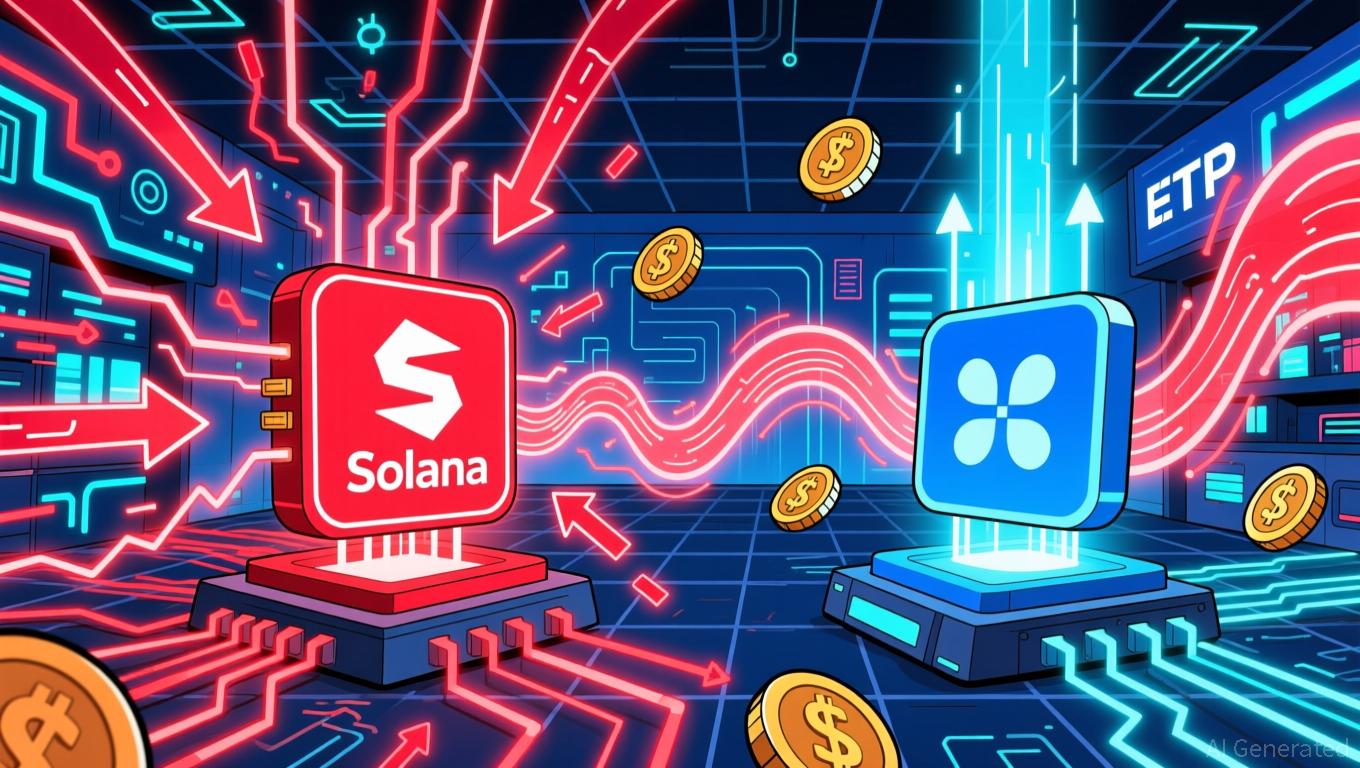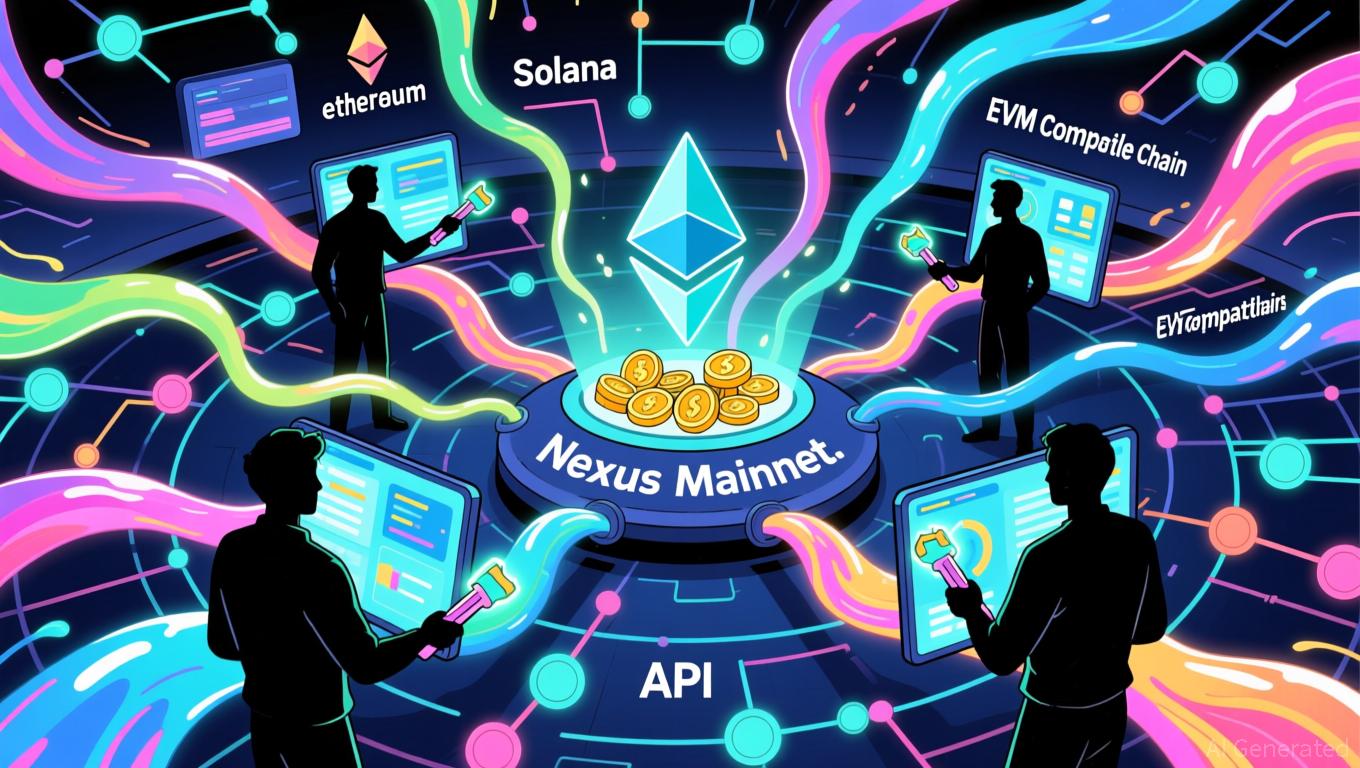ZK Atlas Enhancement: Driving Institutional Embrace Amid the Blockchain Scalability Competition
- ZKsync's Atlas Upgrade solves throughput bottlenecks with Airbender RISC-V zkVM, enabling 15,000+ TPS at $0.0001 per transaction. - Modular ZKsync OS reduces gas fees by 70% since 2023, enabling real-time financial applications while maintaining regulatory compliance. - Deutsche Bank and UBS test ZKsync for asset tokenization, highlighting its institutional appeal through privacy-preserving ZK features and sub-second finality. - Upcoming Fusaka upgrade aims to push TPS to 30,000 by December 2025, but reg
ZKsync Atlas Upgrade: Transforming Institutional Blockchain Adoption

The blockchain sector has consistently faced the challenge of achieving a balance between security, decentralization, and scalability. In 2025, the ZKsync Atlas Upgrade emerges as a game-changing development, setting new standards for both technology and economics within Ethereum Layer 2 (L2) solutions. By introducing the Airbender RISC-V zkVM and a modular ZKsync operating system, this upgrade not only overcomes throughput limitations but also meets the rigorous compliance and performance requirements of institutional users. This overview examines how Atlas's advancements could drive a new wave of institutional engagement in L2 solutions, fundamentally altering the blockchain infrastructure landscape.
Breakthrough Technology: Airbender zkVM and Modular OS
At the heart of the Atlas Upgrade is the Airbender RISC-V zkVM, which delivers over 15,000 transactions per second at a cost of just $0.0001 per transaction. This marks a significant improvement over traditional optimistic rollups like Arbitrum and Optimism, which depend on delayed finality for fraud detection. By compiling execution to RISC-V for proof generation, Airbender removes the risk of inconsistent logic between execution and verification, thereby boosting both security and efficiency.
Supporting this is the modular ZKsync OS, which has cut gas fees by 70% since 2023. This dramatic reduction is crucial for institutions aiming to launch real-time financial services, such as instant asset settlements or high-frequency trading. The modular design also empowers organizations to create private or semi-public Ethereum-linked chains while upholding regulatory standards and transparency. Notably, major banks like Deutsche Bank and UBS have already piloted ZKsync's infrastructure for asset tokenization, benefiting from its privacy-centric zero-knowledge features.

Driving Institutional Adoption: Compliance, Liquidity, and Instant Settlement
Historically, institutions have been reluctant to embrace blockchain due to hurdles such as regulatory uncertainty, fragmented liquidity, and inadequate performance. The Atlas Upgrade directly tackles these issues:
- Regulatory Alignment: The ZK Stack bridges liquidity between Ethereum's mainnet and Layer 2, minimizing fragmentation and enabling rapid cross-layer transactions. This is especially beneficial for institutions navigating complex regulatory landscapes, as it ensures smooth asset transfers with full auditability. ZKsync's governance—comprising the Token Assembly, Security Council, and Guardians—adds further protection against centralized control, a key concern for traditional finance.
- Real-Time Settlement: The upgrade introduces a next-generation sequencer capable of handling 25,000–30,000 transactions per second with near-instant finality. This is vital for applications that demand immediate transaction confirmation. For instance, Deutsche Bank's exploration of ZKsync for real-time asset tokenization highlights the platform's potential to replace outdated systems with lengthy settlement times.
- Enterprise-Ready Infrastructure: ZKsync enables the deployment of private chains with zero-knowledge privacy, making it highly attractive for regulated industries. Organizations can now implement blockchain solutions without exposing sensitive information, meeting the needs of sectors like healthcare and supply chain management.
ZKsync vs. Optimism and Arbitrum: A Comparative Perspective
Although Optimism and Arbitrum are well-established in the L2 ecosystem, the Atlas Upgrade positions ZKsync as the preferred choice for institutions that value high throughput and rapid finality. By late 2025, ZKsync boasts over 15,000 transactions per second with one-second finality, surpassing Optimism's and Arbitrum's daily transaction volumes. However, the latter platforms still offer advantages in developer tools and compatibility.
Governance models also set these platforms apart. ZKsync's multi-faceted governance structure offers a more decentralized approach compared to Optimism's token-based system, which may appeal to risk-conscious institutions. Meanwhile, Arbitrum's optimistic rollup, while developer-friendly, continues to lag in finality due to its reliance on challenge periods.
Looking Ahead: Fusaka Upgrade and Regulatory Challenges
The Atlas Upgrade is just one step in ZKsync's ongoing evolution. The forthcoming Fusaka upgrade, scheduled for December 2025, aims to increase throughput to 30,000 TPS while addressing interoperability and regulatory complexities. This progression signals ZKsync's ambition to become a foundational provider for institutional blockchain infrastructure.
Nevertheless, regulatory ambiguity remains a significant variable. While ZKsync's compliance-oriented design reduces certain risks, global regulatory bodies are still developing frameworks for tokenized assets and cross-border transactions. Institutions leveraging ZKsync must stay alert to shifting legal requirements, especially in regions like the EU and the United States.
Investment Perspective
For investors, the Atlas Upgrade represents a convergence of technological progress and growing institutional interest. The increasing total value locked in ZKsync's ecosystem reflects rising confidence in its capabilities. The upgrade's emphasis on instant settlement and regulatory compliance aligns with broader trends such as asset digitization and the demand for faster financial systems.
In comparison, Optimism and Arbitrum's dependence on optimistic rollups may limit their appeal to institutions that prioritize speed and certainty. While these platforms are likely to retain their user communities, ZKsync's technological advantages could enable it to capture a larger share of the institutional market, particularly in banking and asset tokenization.
Summary
The ZK Atlas Upgrade marks a pivotal moment for institutional blockchain adoption. By overcoming challenges related to scalability, compliance, and performance, ZKsync has established itself as a credible alternative to conventional financial infrastructure. As future upgrades like Fusaka roll out, the platform's ability to adapt to regulatory and technological changes will be key to its sustained leadership in the Layer 2 arena. For investors and institutions alike, ZKsync's advancements are not only redefining scalability but also shaping the future of blockchain in the enterprise world.
Disclaimer: The content of this article solely reflects the author's opinion and does not represent the platform in any capacity. This article is not intended to serve as a reference for making investment decisions.
You may also like
Ethereum News Update: Amundi’s Integrated Approach Connects Blockchain with Conventional Financial Regulations
- Amundi, Europe's largest asset manager, launched its first Ethereum-based tokenized money-market fund, enabling 24/7 settlements and transparent record-keeping via blockchain. - The hybrid model, developed with CACEIS, combines traditional fund operations with blockchain-based ownership, preserving regulatory compliance while expanding investor access. - Ethereum's dominance in stablecoin and RWA transfers ($105.94B in 30 days) underscores its role in accelerating tokenization, with Amundi positioning it

XRP News Today: XRP ETFs Drive Price Increases, While Solana ETFs Ease Selling Pressure
- XRP ETFs raised $587M in inflows since late November, outpacing Solana's $568M as investors favor altcoins with regulatory clarity and utility. - Bitwise XRP ETF's $107M debut and zero-fee strategy drove momentum, while Solana ETFs faced $156M weekly outflows due to network reliability concerns. - XRP's inflows acted as a "battering ram" pushing prices above $2.27, contrasting Solana's ETFs which merely dampened sell pressure without reversing its decline. - Analysts predict XRP could reach $3 by Decembe

The Federal Reserve's Change in Policy and Its Impact on Alternative Cryptocurrencies Such as Solana
- Fed's 2025 policy shifts, including rate cuts and stablecoin regulations, are reshaping altcoin markets by altering liquidity and risk appetite. - Solana's Alpenglow upgrade (150ms finality, 1M TPS) addresses scalability issues, aligning with Fed's AI-driven infrastructure focus despite network reliability concerns. - Institutional inflows into Solana ETFs ($100M AUM) contrast with retail caution (78% HODLers in red), highlighting divergent risk perceptions amid 30% price corrections. - Divergent ETF flo

Avail's Intent-Driven Nexus Addresses the Issue of Fragmented Liquidity Across Chains
- Avail launches Nexus Mainnet, a cross-chain solution unifying liquidity across Ethereum , Solana , and EVM networks. - The intent-solver model enables seamless asset transfers without technical complexities, streamlining user experiences. - Developers gain modular tools for multichain integration, reducing costs as cross-chain liquidity demand grows. - Nexus abstracts execution layers, offering unified balances and execution while addressing fragmentation challenges. - With $50B+ in cross-chain activity
